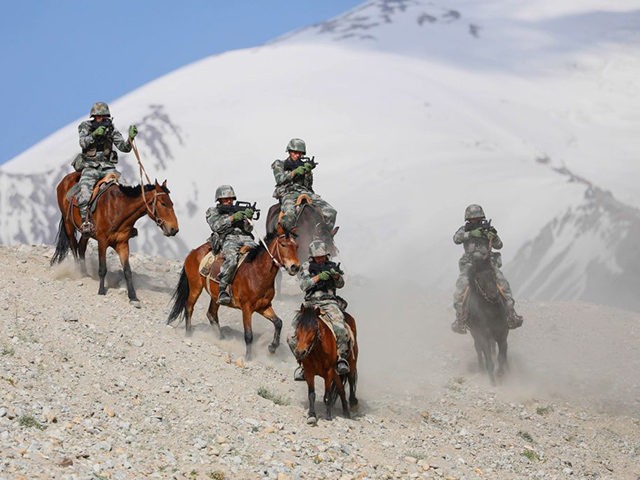The South China Morning Post and the Economic Times of India have both recently reported that the Chinese Communist Party has withdrawn as many as 10,000 soldiers from the Line of Actual Control (LAC), the official name for the Chinese border with India.
The Morning Post reported, citing unnamed “sources and reports” Tuesday, that the move was allegedly the product of the Chinese military concluding that conflict with India would be unlikely during the winter. The LAC lies in extremely difficult-to-navigate mountainous terrain, prone to intense blizzards and avalanches. Even in the summer months, the snowy geography requires significant military training.
The move, if confirmed, follows a turbulent half-year in the Himalayas for both China and India. In June, at the height of summer, a brawl erupted between soldiers from both countries, prompted by Indian troops discovering Chinese soldiers present illegally within India. In response to questioning from the Indian border troops, the Chinese reportedly attacked them with rocks and sticks. The incident resulted in tremendous military embarrassment for China, as the Indian Army reportedly killed twice as many, about 40, Chinese soldiers as they lost.
The Chinese Communist Party never issued a death count or identified any of the soldiers killed or injured in the incident. The Global Times, a Chinese Communist Party mouthpiece, referred to some of the soldiers involved as “martyrs” months after the clash, confirming at least two deaths occurred.
Following that brawl, the Indians and Chinese clashed again in September, after India ended decades of precedent and allowed its troops to carry firearms (the firearms ban was responsible for the use of rudimentary weapons in the initial clash). That month, Indian troops took over a strategic mountaintop over Pangong Tso, a lake in occupied Tibet. China claims the Indians unlawfully occupied the territory but has failed to act to remove them.
Now, in the dead of winter, China has reportedly begun to bring troops out of the Himalayas, the first reports of retreat after months of indications that China was significantly increasing its presence there.
“The withdrawal started more than two weeks ago. All the troops were pulled back in military vehicles, so the Indian side could see it,” one of the unnamed sources told the Morning Post.
The report is consistent with what the Economic Times claimed on January 11.
“China has moved back close to 10,000 troops from the Ladakh border as the winter peaked in the region,” the Times reported, referring to India’s Ladakh border region. “However, frontline positions remain fully manned by Indian and Chinese troops along contentious points on the Line of Actual Control. Sources said that PLA [People’s Liberation Army] moved troops deployed in depth [sic] areas by over 100 km into Tibetan territory as scope for any operations have diminished due to the harsh winter and heavy snow.”
The Economic Times, like the Morning Post, suggested “the Chinese pull back [sic] was necessary as keeping over 50,000 troops at snowbound high altitudes was untenable. However, the situation along the border remains tense as both sides have kept tanks, artillery guns and armoured personnel carriers ready along the border.”
An unnamed official noted that current temperatures in the Himalayan peaks where China is reportedly retreating are under -40º Fahrenheit.
The newspaper noted that, prior to the withdrawal, observers estimated about 50,000 Chinese troops and 50,000 Indian troops were facing off in the region. Indian Defense Minister Rajnath Singh testified at a public hearing in September that China had deployed “a huge number of Army battalions and armaments” to prevent another incident like the one in June, which occurred in India’s Galwan Valley, and that India had responded with “counter-deployments.”
“China doesn’t recognize the traditional and customary alignment of the boundary. We consider that this alignment is based on well established geographical principals,” Singh warned at the time. “India and China border issue remains unresolved. Till now, there has been no mutually acceptable solution. China disagrees on the border.”
The Galwan Valley clash resulted in the removal of General Zhao Zongqi as head of the People’s Liberation Army Western Theater Command, the top military officials responsible for the territory where the clash occurred. Chinese media tepidly announced his departure, noting his retirement age, though observers believe his involvement in the incident played a role, as those still in dictator Xi Jinping’s good graces can often continue in their jobs over the age of 65.
State media did not mention Zhao in its report on his removal from office, instead congratulating successor Zhang Xudong on his new role.
The harsh winter conditions have cooled military activity on the LAC, but not fully stopped it. Last week, media from both countries revealed the Indian government had captured a Chinese soldier illegally present on its side of the border, reportedly mulling around the banks of Pangong Tso. In a statement, the Indian army noted that the transgression did not appear to be a threat to India and that the soldier was “being dealt with.” Indian authorities returned him to China this week.

COMMENTS
Please let us know if you're having issues with commenting.